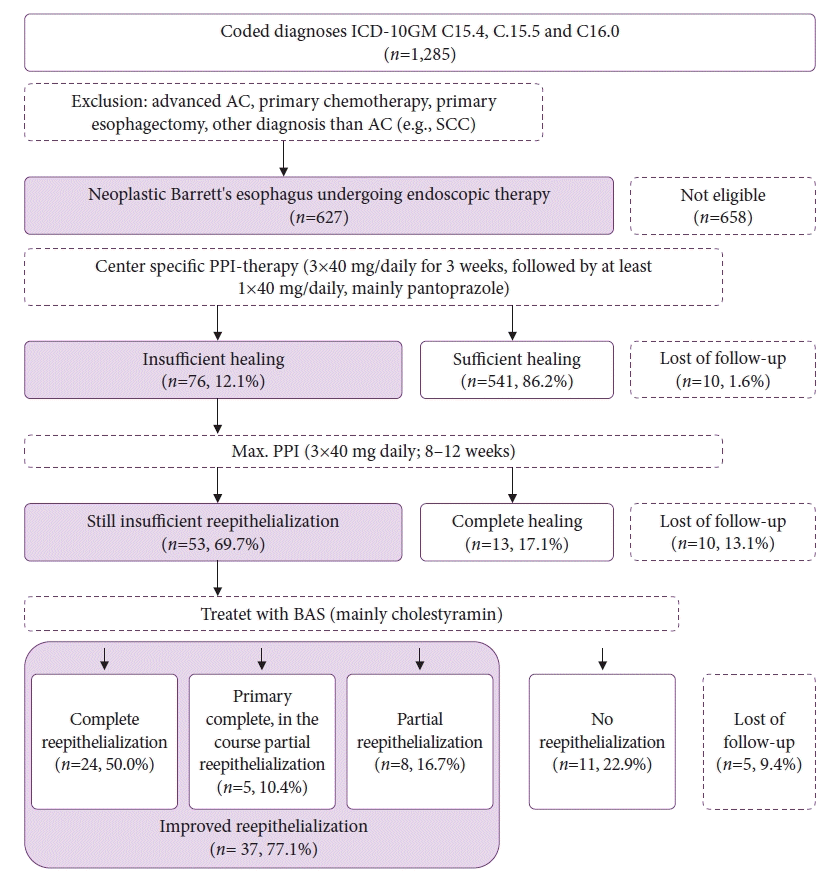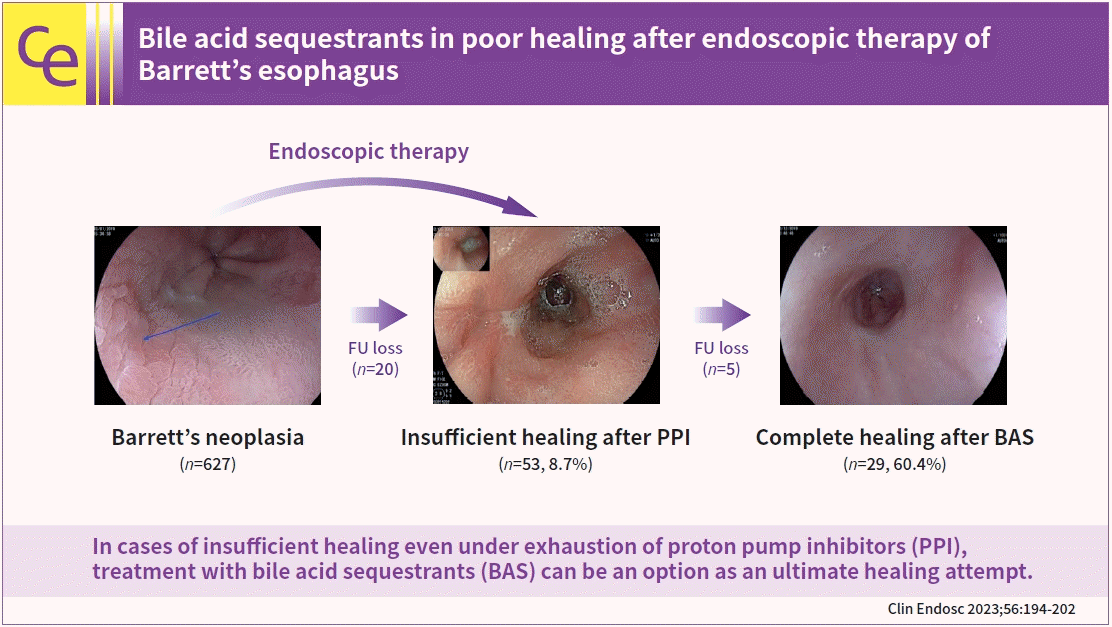1. Standards of Practice Committee, Wani S, Qumseya B, et al. Endoscopic eradication therapy for patients with Barrett's esophagus-associated dysplasia and intramucosal cancer. Gastrointest Endosc. 2018; 87:907–931.
2. Weusten B, Bisschops R, Coron E, et al. Endoscopic management of Barrett's esophagus: European Society of Gastrointestinal Endoscopy (ESGE) position statement. Endoscopy. 2017; 49:191–198.
3. van Munster SN, Frederiks CN, Nieuwenhuis EA, et al. Incidence and outcomes of poor healing and poor squamous regeneration after radiofrequency ablation therapy for early Barrett's neoplasia. Endoscopy. 2022; 54:229–240.
4. Tan MC, Kanthasamy KA, Yeh AG, et al. Factors associated with recurrence of Barrett's esophagus after radiofrequency ablation. Clin Gastroenterol Hepatol. 2019; 17:65–72.
5. Cotton CC, Wolf WA, Overholt BF, et al. Late recurrence of Barrett's esophagus after complete eradication of intestinal metaplasia is rare: final report from ablation in intestinal metaplasia containing dysplasia trial. Gastroenterology. 2017; 153:681–688.
6. Phoa KN, van Vilsteren FG, Weusten BL, et al. Radiofrequency ablation vs endoscopic surveillance for patients with Barrett esophagus and low-grade dysplasia: a randomized clinical trial. JAMA. 2014; 311:1209–1217.
7. May A, Gossner L, Pech O, et al. Local endoscopic therapy for intraepithelial high-grade neoplasia and early adenocarcinoma in Barrett's oesophagus: acute-phase and intermediate results of a new treatment approach. Eur J Gastroenterol Hepatol. 2002; 14:1085–1091.
8. Manner H, Rabenstein T, Pech O, et al. Ablation of residual Barrett's epithelium after endoscopic resection: a randomized long-term follow-up study of argon plasma coagulation vs. surveillance (APE study). Endoscopy. 2014; 46:6–12.
9. Oh DS, Demeester SR. Pathophysiology and treatment of Barrett's esophagus. World J Gastroenterol. 2010; 16:3762–3772.
10. Huo X, Juergens S, Zhang X, et al. Deoxycholic acid causes DNA damage while inducing apoptotic resistance through NF-κB activation in benign Barrett's epithelial cells. Am J Physiol Gastrointest Liver Physiol. 2011; 301:G278–86.
11. Quante M, Bhagat G, Abrams JA, et al. Bile acid and inflammation activate gastric cardia stem cells in a mouse model of Barrett-like metaplasia. Cancer Cell. 2012; 21:36–51.
12. Matsuzaki J, Suzuki H, Tsugawa H, et al. Bile acids increase levels of microRNAs 221 and 222, leading to degradation of CDX2 during esophageal carcinogenesis. Gastroenterology. 2013; 145:1300–1311.
13. O'Riordan JM, Abdel-latif MM, Ravi N, et al. Proinflammatory cytokine and nuclear factor kappa-B expression along the inflammation-metaplasia-dysplasia-adenocarcinoma sequence in the esophagus. Am J Gastroenterol. 2005; 100:1257–1264.
14. Cattelan L, Ghazawi FM, Le M, et al. Epidemiologic trends and geographic distribution of esophageal cancer in Canada: a national population-based study. Cancer Med. 2020; 9:401–417.
15. Knabe M, Beyna T, Rösch T, et al. Hybrid APC in combination with resection for the endoscopic treatment of neoplastic Barrett's esophagus: a prospective, multicenter study. Am J Gastroenterol. 2022; 117:110–119.
16. Knabe M, Wetzka J, Kronsbein H, et al. Hybrid argon-plasma-koagulation versus radiofrequenzablation nach endoskopischer resektion neoplastischer läsionen im Barrettösophagus. Eine randomisierte studie an einem tertiären zentrum. Z Gastroenterol. 2020; 58:e142.
17. Knabe M, Blößer S, Wetzka J, et al. Non-thermal ablation of non-neoplastic Barrett's esophagus with the novel EndoRotor® resection device. United European Gastroenterol J. 2018; 6:678–683.
18. Knabe M, Welsch L, Blasberg T, et al. Artificial intelligence-assisted staging in Barrett's carcinoma. Endoscopy. 2022; 54:1191–1197.
19. Knabe M, Beyna T, Rösch T, et al. Hybrid APC in combination with resection for the endoscopic treatment of neoplastic Barrett's esophagus: a prospective, multicenter study. Am J Gastroenterol. 2022; 117:110–119.
20. Pech O, May A, Manner H, et al. Long-term efficacy and safety of endoscopic resection for patients with mucosal adenocarcinoma of the esophagus. Gastroenterology. 2014; 146:652–660.
21. Peerally MF, Bhandari P, Ragunath K, et al. Radiofrequency ablation compared with argon plasma coagulation after endoscopic resection of high-grade dysplasia or stage T1 adenocarcinoma in Barrett's esophagus: a randomized pilot study (BRIDE). Gastrointest Endosc. 2019; 89:680–689.
22. Kwon JY, Kesler AM, Wolfsen HC, et al. Hiatal hernia associated with higher odds of dysplasia in patients with Barrett's esophagus. Dig Dis Sci. 2021; 66:2717–2723.
23. Maret-Ouda J, Santoni G, Wahlin K, et al. Esophageal adenocarcinoma after antireflux surgery in a cohort study from the 5 Nordic countries. Ann Surg. 2021; 274:e535–e540.
24. Vaezi MF, Fass R, Vakil N, et al. IW-3718 reduces heartburn severity in patients with refractory gastroesophageal reflux disease in a randomized trial. Gastroenterology. 2020; 158:2093–2103.
25. Kataria R, Rosenfeld B, Malik Z, et al. Distal esophageal impedance measured by high-resolution esophageal manometry with impedance suggests the presence of Barrett's esophagus. J Neurogastroenterol Motil. 2020; 26:344–351.
26. Blößer S, May A, Welsch L, et al. Virtual biopsy by electrical impedance spectroscopy in Barrett's carcinoma. J Gastrointest Cancer. 2022; 53:948–957.
27. Pohl H, Pech O, Arash H, et al. Length of Barrett's oesophagus and cancer risk: implications from a large sample of patients with early oesophageal adenocarcinoma. Gut. 2016; 65:196–201.
28. Avidan B, Sonnenberg A, Schnell TG, et al. Hiatal hernia and acid reflux frequency predict presence and length of Barrett's esophagus. Dig Dis Sci. 2002; 47:256–264.






 PDF
PDF Citation
Citation Print
Print




 XML Download
XML Download